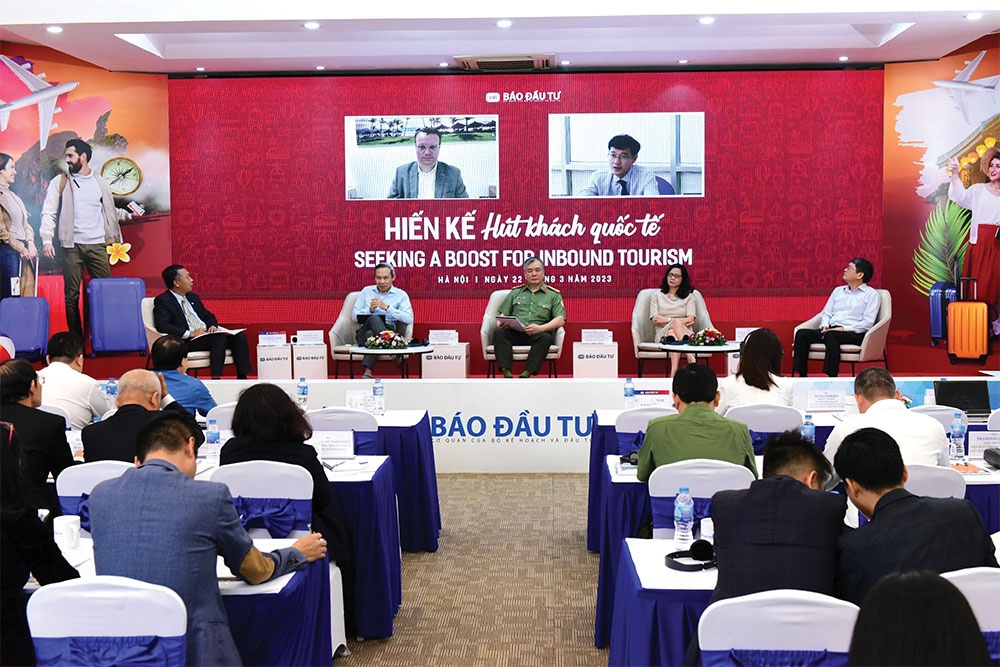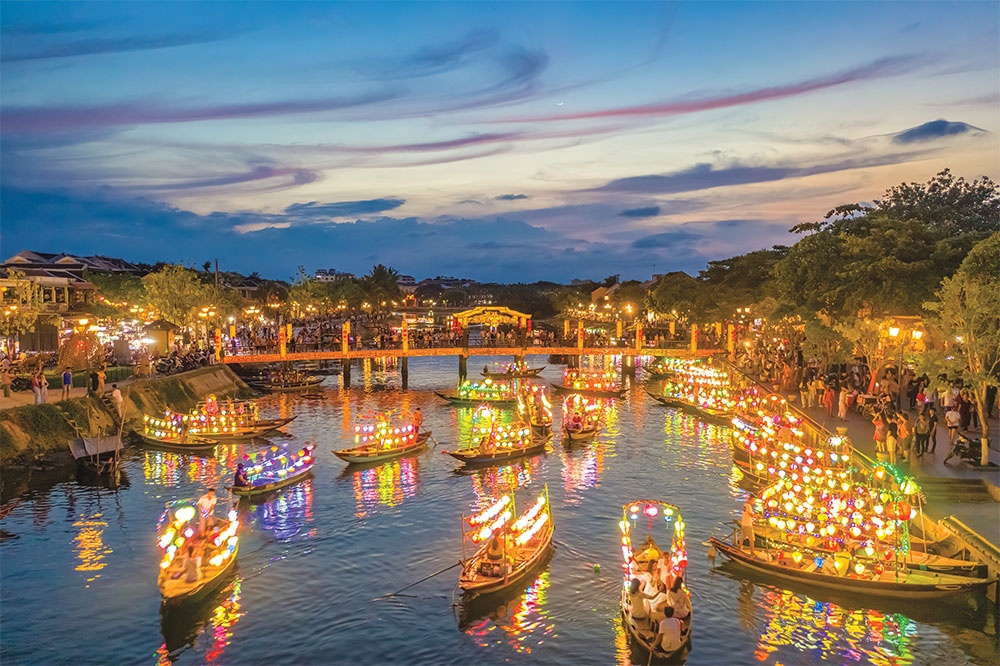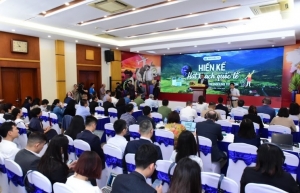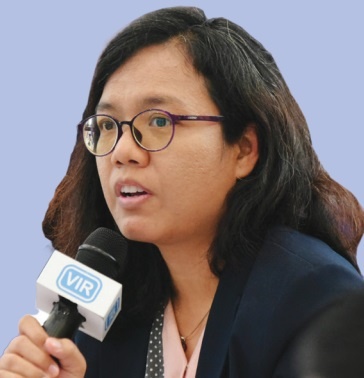Powerful plan mooted for tourism
 |
| Photo: Chi Cuong |
At VIR’s roundtable discussion on seeking a boost for inbound tourism last week, editor-in-chief Le Trong Minh opened the roundtable with a fact-based observation, and noted that the country has yet to unlock the full potential of its tourism industry.
“While the tourism sector contributes a significant 9.2 per cent of the country’s total GDP, equivalent to $32.8 billion, this number remains low compared to the global average,” he said.
In 2023, the tourism sector aims to welcome eight million international visitors. While this is a modest number compared to the level achieved in 2019 of 19 million visitors, it is a challenging target as the market is undergoing many changes and new trends post-pandemic.
Explaining this, Hoang Nhan Chinh, secretariat director of the Vietnam Tourism Advisory Board assessed that group tours are seeing a decline, and tourists known as frequent independent travellers are on the rise.
“An essential step is to understand the targets before building the products,” Chinh said, adding that the coming years present Vietnam with an opportunity to restructure the market.
In the same vein, Duong Minh Duc, deputy director of sales and marketing of Saigontourist Group, agreed that 2023 sees the continuation of the trends that were shaped in 2022: solo and small group travel, remote working travel, and longer-term stays. “As these trends grow stronger, it’s important for tourism companies to create personalised experiences and tailor-made tours,” Duc assessed.
Nguyen Thi Le Huong, deputy general director of Vietravel, speculated that branding and communicating might be the top factors with room for improvement in reinforcing the country’s image in the eyes of international tourists.
“Oftentimes, we attempt every form of tourism promotion possible: experiential tourism, ecotourism, etc. But if we look at some typical global destinations, Bali is known for its beaches, Dubai is known for its shopping centres. With its long coastline, a possible approach for Vietnam would be focusing on promoting resort tourism in Danang, Nha Trang, and Phu Quoc,” Huong said.
All in all, experts reached a consensus that a comprehensive approach from all sectors is crucial for tourism’s holistic recovery. Besides market research and expansion and service development, issues like laws and policies, visas, and immigration are also in play.
Martin Koerner, head of Tourism Working Group at the Vietnam Business Forum (VBF), suggested that even a small improvement in the immigration process can make a difference in revisitation rate.
“Vietnam’s visa policy, if compared to Singapore or Thailand, is quite restrictive and complicated. However, we received feedback from the Ministry of Public Security last week that the extension of visa-exempt countries from 15 to 30 days will happen and that more countries will be added to the visa exemption list. So that’s very good news,” Koerner said. “Service quality at airport immigration areas can also be improved, with shorter waiting times and a more welcoming presence.”
Phan Duc Hieu, a permanent member of the National Assembly Economic Committee, added that a tourism mindset should start even from policy planning.
“In terms of policy, tourism development doesn’t involve only tourism laws or immigration laws – it can involve planning of land, housing, and infrastructure policies. A tourism-oriented mindset should be employed to avoid future policies that might create bottlenecks,” Hieu noted.
Nuno Ribeiro, deputy senior programme manager for Tourism and Hospitality Management at RMIT Vietnam, was meanwhile cautiously optimistic about the tourism industry. He assessed that diversifying source markets while extending tourists’ number of visits and length of stay were sound development strategies.
“If you look at the top 10 tourist origins that visited Vietnam from 2012 onwards, you will see that there are five or six countries that persistently show up in the statistics,” Ribeiro said. “On one hand, this is very good news and means that we are able to attract repeat visitors from those markets. But at the same time, it is never good for a country to be dependent on a small number of countries. We want to diversify that as much as possible.”
He cited statistics showing that Vietnam is still considered a “once in a lifetime” destination, with a revisitation rate on average for all international tourists raging around only 8-10 per cent.
“Length of stay also matters, as the longer international tourists stay in the country, the higher their expenditure will go. It is an exponential relationship. A tourist who stays more than one week will spend almost two times as much as someone who stays fewer than seven days,” Ribeiro noted.
 |
| Nareekarn Srichainak - First secretary The Royal Thai Embassy in Hanoi | |
In order to revive tourism, we brought out the Phuket Sandbox mechanism with strong cooperation between the public and private sector. From October 2020 to September 2021, we targeted international arrivals from low-risk parts of the world; then in March-April 2021 we allowed international tourists to enter Thailand through Phuket with the condition that they had to spend the first seven days in tourism facilities in Phuket. All operating systems and execution were calculated carefully, and with the success of the Phuket Sandbox, we expanded to other areas for international tourists. The Royal Thai Embassy in Hanoi also cooperated with Quang Ninh province to share experience from the sandbox. We also promoted tourism in the domestic market while waiting for international arrivals to pick up by reducing prices for flights, transportation, and accommodation to keep the entire sector going. We also utilised information technologies and statistics to draw suitable strategies. Additionally, international cooperation is also important, as we signed MoUs with India and Saudi Arabia to form tourism bubbles. We targeted specific niche markets such as golfers, medical tourism, and LGBT tourism. We have launched the campaign “Amazing Thailand, Amazing New Chapters” with a focus on a wide range of choices and services for various segments of guests. In 2022, international arrivals to Thailand hit 11 million but it is still lower than 2019. Last year, Vietnamese tourists accounted for 4.4 per cent of total international arrivals to Thailand and stands around 3.3 per cent recently. | |
| Ance Maylany Napitupulu - Counsellor Indonesian Embassy to Vietnam | |
Making tourism a priority and building collaborations across ministries are important, and those are the lessons that we have been learning. Now, we want to see that tourism is not just about bringing visitors, but we want them to feel at home and we want them to experience everything that we offer. Visa policy is an important part to supporting the access of tourists, but is not the only solution to increasing tourism. Tourism is about building brands which will create quality assurance of the destination and it is about establishing good memories which will encourage more visits of future tourists, and therefore gain repeated visits. We get that experience for Bali, and we have repeated visitors from Australia who consider Bali as their backyard, and Malaysian and Singaporeans who consider Indonesia as their second home. |
 | Expert opinions on prospects of luring more foreign visitors to Vietnam Industry professionals advise on the fact that Vietnam has not made significant progress in luring foreign visitors, despite offering a great deal of potential for tourism sector growth. |
What the stars mean:
★ Poor ★ ★ Promising ★★★ Good ★★★★ Very good ★★★★★ Exceptional
Related Contents
Latest News
More News
- The destinations powering Vietnam’s festive season travel demand (December 04, 2025 | 18:33)
- Vietnam named among the world’s most exciting winter destinations (December 04, 2025 | 15:10)
- Phu Tho emerges as northern Vietnam’s new tourism hub (December 01, 2025 | 17:00)
- Vietjet completes Airbus A320/A321 updates ahead of deadline (December 01, 2025 | 09:49)
- Vietjet resumes Con Dao flights from early December (November 28, 2025 | 15:24)
- Free tickets, Lunar New Year promotions on offer at Vietjet Mega Livestream (November 26, 2025 | 15:32)
- Scandinavian Airlines and Vietnam Airlines broaden agreement with new routes (November 25, 2025 | 17:04)
- Halong Cruise Port welcomes over 3,100 international visitors (November 12, 2025 | 18:06)
- Vietnam.travel climbs to second place in Southeast Asia website rankings (November 12, 2025 | 18:01)
- Cat Ba named among Southeast Asia’s top island adventures (November 11, 2025 | 18:09)



 Tag:
Tag:





















 Mobile Version
Mobile Version